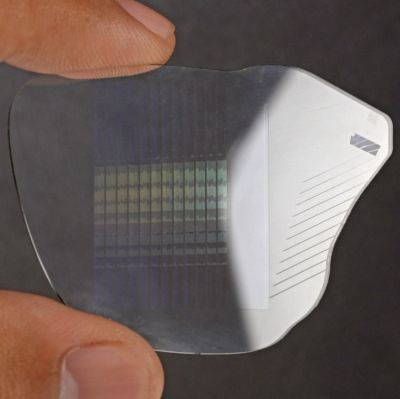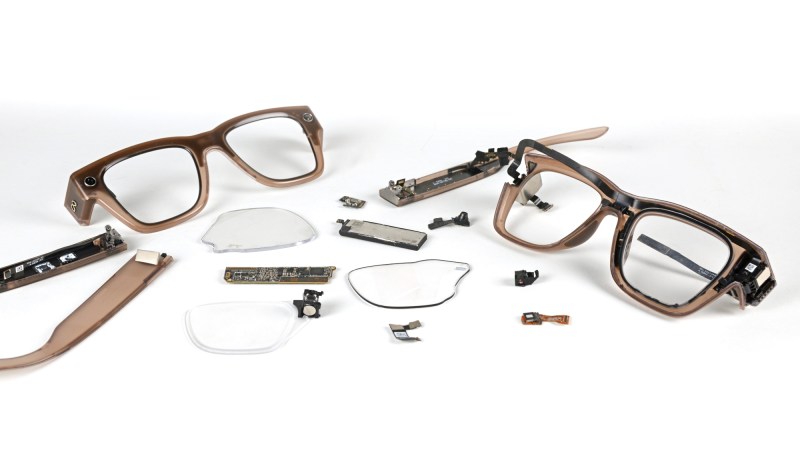
Recently the avid teardown folk over at iFixit got their paws on Meta’s Ray-Ban Display glasses, for a literal in-depth look at these smart glasses. Along the way they came across the fascinating geometric waveguide technology that makes the floating display feature work so well. There’s also an accompanying video of the entire teardown, for those who enjoy watching a metal box cutter get jammed into plastic.
Overall, these smart glasses can be considered to be somewhat repairable, as you can pry the arms open with a bit of heat. Inside you’ll find the 960 mWh battery and a handful of PCBs, but finding spare parts for anything beyond perhaps the battery will be a challenge. The front part of the glasses contain the antennae and the special lens on the right side that works with the liquid crystal on silicon (LCoS) projector to reflect the image back to your eye.
While LCoS has been used for many years already, including Google Glass, it’s the glass that provides the biggest technological advancement. Instead of the typical diffractive waveguide it uses a geometric reflective waveguide made by Schott, with the technology developed by Lumus for use in augmented reality (AR) applications. This is supposed to offer better optical efficiency, as well as less light leakage into or out of the waveguide.
Although definitely impressive technology, the overall repairability score of these smart glasses is pretty low, and you have to contest with both looking incredibly dorky and some people considering you to be a bit of a glasshole.
















I hope for LInux support with Gnome and KDE Plasma Desktops incorporate AR support in the near future and treat it like another monitor. I am glad AR is maturing.
600×600 pixels does not lend itself for a desktop type interface.
And at $800 it’s ‘neat but too dear’ IMHO
Not that I’m into the Meta world anyway to be fair, and they have the ‘glasshole’ camera aspect as Maya says, and they are glasses you are suppose to wear in regular life instead as only for a sit-down.
Back in the day, we worked with less and loved it!
Not really, even Windows 95 required 640 x 480 screen and for maximum productivity people typically used 1024 x 768.
The OG mac had 512 × 342 and nevermind thr atari st and amiga’s that also shipped with a gui desktop
I used to get a lot of work done on a 512 x 342 pixels B+W screen.
XRdesktop could be what you want then, it already exists and I’ve played with it, admittedly on a Vive, so really wasn’t very useable as the resolution density just isn’t there in the early VR headsets. But it did exactly what you need seamlessly bring your desktop windows into a virtual space to layout however you like.
Not tried it but I understand Breezy-desktop might be a good option too.
Ah, back in the days when lenses were thick and square.
The video describes doing the impossible, but doing it in impossible ways on impossible scales. I know a great deal about technology, but this is indistinguishable from magic.
Magic so strong that it becomes a good by virtue of its strength we call technology.
These are incredible feats of engineering but the idea of having Mark Zuckerberg glued to my face like a brain slug is beyond awful.
Please! gross gross gross !!! Thought makes me want to vomit & heave !!!
Levity aside.
I would hope the audience here would shun this product.
It’s a tool that will only accelerate the dystopian vision of a future where ones ability to remain anonymous is stripped away. Useful idiots (adopters of this product) being nothing but pawns and puppets of corporate masters exploiting the ignorant masses with shiny objects, for the benefit of harvesting & selling their data.
Make no mistake, these marvelous inventions were not intended to benefit humanity, but to profit off the ignorance of the proletariat hordes. The same fools that wait hours in line to purchase a new phone for 4 figures and eagerly hand over their $$$ (while simultaneously demanding student loan bailouts).
Shun this evil tool of Satan ! shun it, send it back to the depths of Hell where it was conceived !
The actual hardware seems pretty darn useful, getting to good enough resolution and onboard hardware for communication – can you imagine for us HAD folks for instance having the Oscope or multimeter screen always in your FOV while your are fiddling with the tiny probes you know you should solder wires onto for but don’t want to bother…
You just have to figure out how to leech the Meta poision out so the hardware can be used and owned. Or find the alternative that isn’t terrible.
This is effing amazing, I have to say…
Ah, Lumus, so that’s what military pilots have in their helmet’s visors.
Would have been better as an ifixit photo diary style instead of youtube :)
I’ll never get tired of seeing that even the tiniest devices have a ton of connectors inside of them. Having done a little bit of laptop and phone surgery, i’m also impressed how durable / reusable / secure / easy-to-disconnect these connectors usually are. It also shows clear opportunities to reduce size much further! Like, obviously some space could be saved by removing the connectors and turning some of these boards into lumps on the cable. But also what i assume is the display connector has a fantastically huge number of pins…that’s obviously headed in a decade or so towards a serial interface with a 4-wire cable instead
Too bad that they chose to go with one of the weakest of Lumus waveguide offerings. Ive got a Lenovo A6 running their top down 1920X1080 Vision waveguide with 40 degree FOV but I would love if some company would push a product out with this form factor using the 50 degree fov 1440×1440 side feeding Lumus Maximus or the 1024×1024 Zlens. Either would have been a better more useful choice than what they went with.
But what to do if a person needs conventional glasses because of eyesight issues: nearsightedness, farsightedness, astigmatism, bifocals, etc? Given the complexity with manufacturing the special glass, I can see that it is a long ways out to accommodate users that need conventional glasses… unless they make a version that somehow covers existing glasses… which would look very clunky.
Lumus/Schott has the ability to produce prescription adjusted waveguides but to date none of their manufacturing partners are offering a product that takes advantage of this ability.
PS I just I wear contacts with my Lenovo A6.